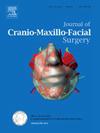Facial asymmetry in syndromic craniosynostosis patients undergoing midface surgery compared to a large general population
IF 2.1
2区 医学
Q2 DENTISTRY, ORAL SURGERY & MEDICINE
引用次数: 0
Abstract
This study aimed to assess mean facial asymmetry (MFA) before and after midface surgery (Le Fort III, monobloc, or facial bipartition) in syndromic craniosynostosis patients and compare it to the general population. This retrospective study included 55 patients (22 Apert, 23 Crouzon, 10 craniofrontonasal dysplasia (CFNS)) with a mean age of 11.5 ± 5.5 at midface surgery, and 2304 general children from the Generation R study (ages 9 and 13 years). An automated algorithm quantified MFA from three-dimensional (3D) meshes created from preoperative CT-scans, registered to the postoperative scans, and from 3D images in the control population, generating a MFA value in millimeters to reflect the degree of asymmetry. Preoperative MFA was 2–2.5 times higher in patients than in controls, with the highest values in Apert (1.18 ± 0.36 mm), followed by CFNS (1.12 ± 0.48 mm), Crouzon (1.02 ± 0.50 mm), and controls (0.45 ± 0.10 mm at age 9 years and 0.47 ± 0.10 mm at age 13 years). Postoperatively, MFA increased in 32 patients (58.2 %) and decreased in 23 (41.2 %). MFA was higher in the study population, especially in Apert syndrome, with variability across syndromes and surgical groups. An automated framework for 3D MFA analysis was presented, aiding objective studies and understanding of facial asymmetry changes in syndromic craniosynostosis.
与大量普通人群相比,接受面中手术的综合征性颅缝闭闭患者面部不对称。
本研究旨在评估综合征性颅缝闭闭患者中面部手术(Le Fort III、单片手术或面部双分割)前后的平均面部不对称(MFA),并将其与一般人群进行比较。本回顾性研究包括55例患者(22例Apert, 23例Crouzon, 10例颅额鼻发育不良(CFNS)),中面部手术时平均年龄为11.5±5.5岁,以及来自R代研究的2304名普通儿童(9岁和13岁)。一种自动算法通过术前ct扫描生成的三维(3D)网格量化MFA,注册到术后扫描,以及对照人群的3D图像,生成以毫米为单位的MFA值,以反映不对称程度。患者术前MFA是对照组的2-2.5倍,其中Apert最高(1.18±0.36 mm),其次是CFNS(1.12±0.48 mm)、Crouzon(1.02±0.50 mm)和对照组(9岁时0.45±0.10 mm, 13岁时0.47±0.10 mm)。术后MFA增高32例(58.2%),降低23例(41.2%)。MFA在研究人群中较高,特别是在Apert综合征中,不同综合征和手术组之间存在差异。提出了一种用于三维MFA分析的自动化框架,有助于客观研究和理解综合征性颅缝闭闭患者面部不对称的变化。
本文章由计算机程序翻译,如有差异,请以英文原文为准。
求助全文
约1分钟内获得全文
求助全文
来源期刊
CiteScore
5.20
自引率
22.60%
发文量
117
审稿时长
70 days
期刊介绍:
The Journal of Cranio-Maxillofacial Surgery publishes articles covering all aspects of surgery of the head, face and jaw. Specific topics covered recently have included:
• Distraction osteogenesis
• Synthetic bone substitutes
• Fibroblast growth factors
• Fetal wound healing
• Skull base surgery
• Computer-assisted surgery
• Vascularized bone grafts

 求助内容:
求助内容: 应助结果提醒方式:
应助结果提醒方式:


